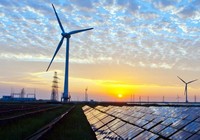Low-Carbon Growth Is a $26 Trillion Opportunity. Here Are 4 Ways to Seize It.
World Resources Institute - We are on the cusp of a new growth era, one where growth is driven by the interaction between rapid technological innovation, sustainable infrastructure investment and increased resource productivity.
 Ambitious climate action across key economic systems—energy, cities, food and land use, water and industry—can lead to higher productivity, more resilient economies and greater social inclusion. It is the growth story of the 21st century.
Ambitious climate action across key economic systems—energy, cities, food and land use, water and industry—can lead to higher productivity, more resilient economies and greater social inclusion. It is the growth story of the 21st century.
Yet we are not making progress fast enough in embracing this growth model. The next 10-15 years are a unique use-it-or-lose-it moment for both the economy and climate. The world will invest $90 trillion in infrastructure by 2030, more than the current stock in place globally today. How that infrastructure is built will be a major determinant of future prosperity for both people and the planet. It is also a key moment to turn the tide on climate change. Already, 18 of the last 19 years have been the warmest on record. Disasters triggered by weather- and climate-related hazards were responsible for thousands of deaths and $320 billion in losses last year. This summer, record-breaking heatwaves, wildfires and extreme flooding turned deadly and caused billions in damages. Unless we make a decisive shift now to a low-carbon economy, we risk the enormous costs of runaway climate change.
Today, the New Climate Economy launches its 2018 report, Unlocking the Inclusive Growth Story of the 21st Century: Accelerating Climate Action in Urgent Times. It demonstrates the benefits of a new low-carbon growth model and outlines how we can urgently accelerate efforts to achieve it. Bold action could yield a direct economic gain of $26 trillion (cumulative) by 2030 compared with business-as-usual. And this is a conservative estimate. Ambitious climate action could also generate more than 65 million new low-carbon jobs in 2030—equivalent to the entire workforces of the UK and Egypt combined—and could avoid more than 700,000 premature deaths from air pollution by 2030.
The next 2-3 years are a critical window when many of the policy and investment decisions that shape the next 10-15 years will be taken. The Global Commission on the Economy and Climate calls on leaders in government, business and finance to prioritize urgent action on four fronts:
1) Ramp up efforts on carbon pricing and move toward mandatory disclosure of climate-related financial risks.
Major economies should put a price on carbon of at least $40-80 per ton of CO2 by 2020, along with a predictable rising pathway by 2030. Already, 70 countries, states and provinces have carbon prices in place or planned, covering 20 percent of global greenhouse gas emissions. Major economies should also lead the way in phasing out fossil fuel subsidies and harmful agricultural subsidies and tax breaks by 2025.
Fossil fuel subsidy reform and carbon pricing alone could generate an estimated $2.8 trillion in government revenues per year in 2030, equivalent to the GDP of India today. These funds could be used to invest in urgent public priorities.
Accelerating efforts to disclose climate-related financial risks is essential to deliver radical transparency and shift much-needed finance toward low-carbon solutions. More than 390 companies—including investors with assets of a combined market capitalization of more than $7 trillion—have already publicly committed to support the Task Force on Climate-related Financial Disclosure’s recommendations, and a number of them are starting to apply them in their financial disclosures.
2) Accelerate investment in sustainable infrastructure.
Ensuring that infrastructure investments are sustainable is critical. The G20 should continue its work to develop infrastructure as an investment asset class to improve the mobilization of private and long-term finance. Multilateral development banks should double their collective investment in infrastructure, making sure it is sustainable, aiming to invest at least $100 billion per year by 2020.


